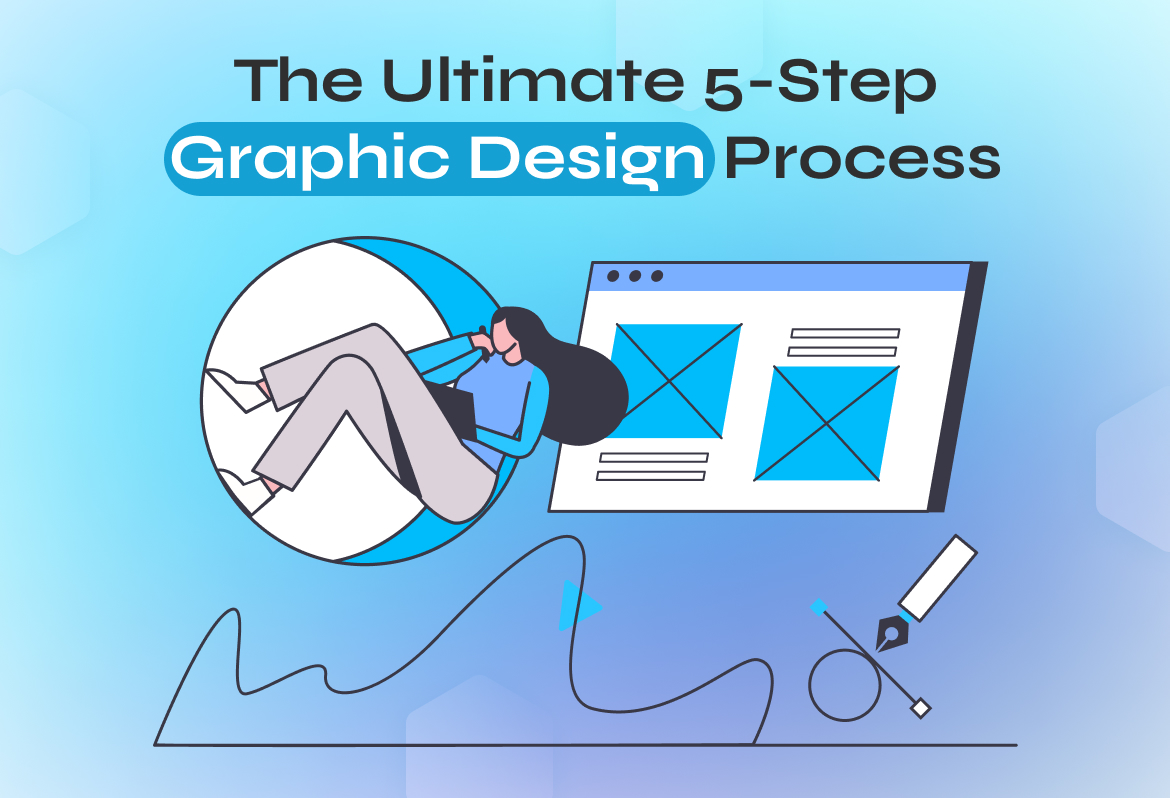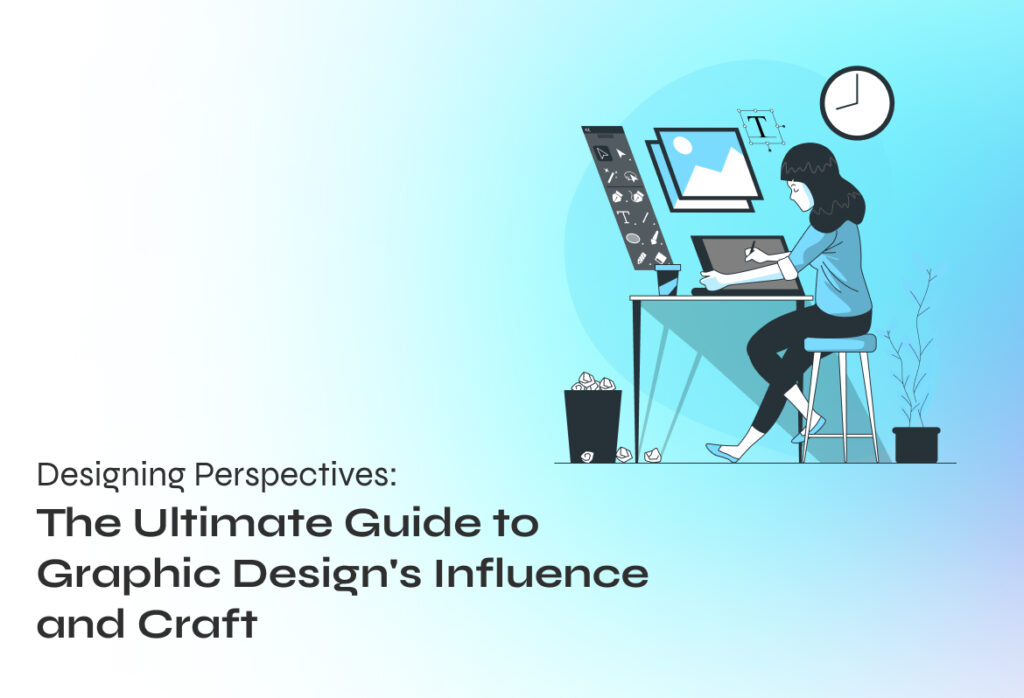In the visually driven world of marketing and communication, graphic design plays an important role in capturing attention, conveying messages, and establishing brand identity. From the layout of a website to the design of product packaging, graphic design is at the heart of visual communication, making it essential for businesses and creators to master.
However, achieving outstanding design outcomes isn’t just about creativity and skill; it requires a structured approach to manage projects efficiently, foster innovation, and meet clients’ expectations. This is where the ultimate 5-step graphic design process comes into play.
This process, refined through years of professional practice, offers a roadmap from conceptualization to delivery, ensuring every project hits its mark. By following these steps, designers can navigate the complexities of creative work, balance multiple projects, and build strong client relationships.
Whether you’re a seasoned designer looking to streamline your workflow or a newcomer eager to learn the ropes, understanding this 5-step process is crucial for success in the fast-paced world of graphic design. Let’s dive into the detailed exploration of each step, shedding light on the strategies, techniques, and insights that make up the backbone of professional graphic design.
Step 1: Brief and Consultation
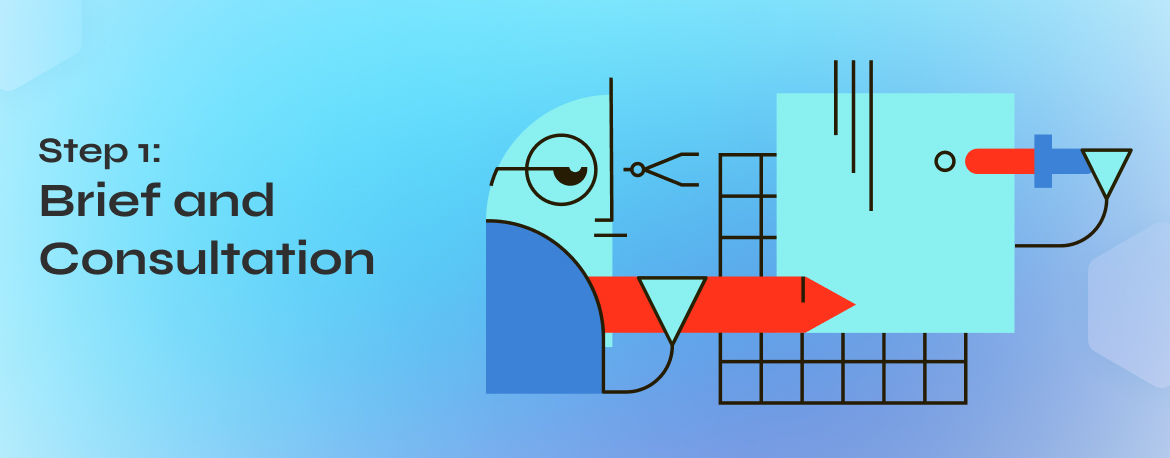
The initial step in the ultimate graphic design process begins long before any actual design work is done. It starts with a Brief and Consultation phase, which lays the foundation for a successful project. This phase is all about understanding client needs, setting expectations, and establishing a collaborative relationship between the client and the designer.
Understanding Client Needs
To create effective graphic designs, it’s crucial to have a deep understanding of the client’s business, goals, target audience, and the message they wish to convey. This understanding is cultivated through detailed discussions, questionnaires, and, sometimes, workshops. It’s about digging deep to uncover not just the surface-level requirements but also the underlying objectives of the project.
Keywords such as “Graphic Design Process” and “What is the graphic design process” are essential here, as they emphasize the methodical approach taken to meet client needs. Designs also aid in communicating with the audience, which is crucial given that stats say around 55% of businesses use graphic design to communicate better with customers. This statistic underscores the importance of graphic design in enhancing business communication with its target audience.
Setting Expectations
Clear communication about timelines, budgets, and deliverables is crucial at this stage. Both the designer and the client need to agree on the scope of work, the milestones, and the final outputs. This clarity helps prevent any misunderstandings later in the project and ensures that everyone is aligned with the process steps and expected outcomes.
Collaboration
The phase is also about establishing a partnership between the client and the designer. Effective collaboration is key to a successful graphic design project. This involves regular communication, openness to feedback, and a shared commitment to achieving the best possible outcome. This phase embodies the “graphic design creative process,” highlighting the importance of mutual understanding and teamwork in creating compelling designs.
Step 2: Research and Inspiration
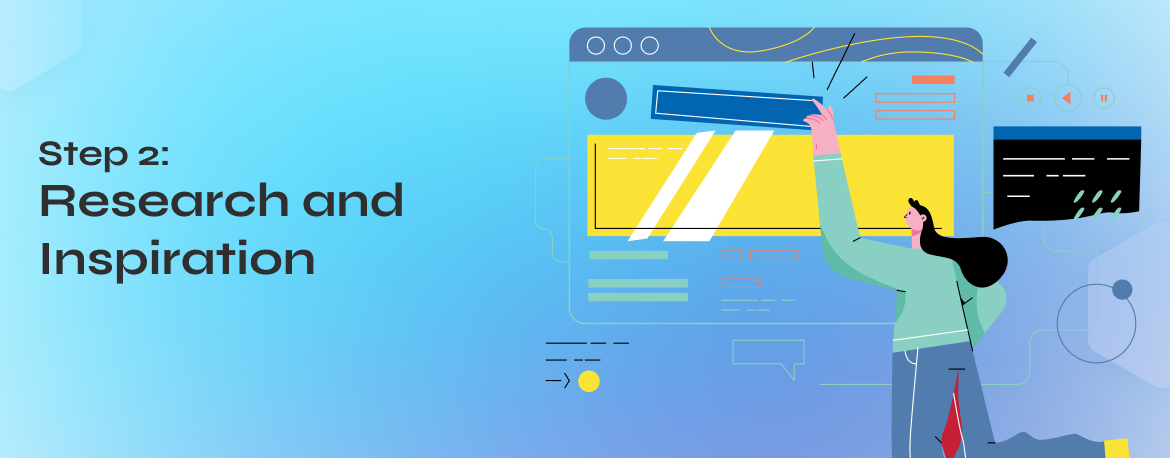
Following a thorough briefing and consultation, the next step is Research and Inspiration. This phase is critical for grounding the project in reality while also seeking creative sparks to drive the design forward.
Market Research
Understanding the market, the competition, and the target audience’s preferences is essential. This involves analyzing similar designs, trends in the industry, and the visual languages that resonate with the intended audience. This research ensures that the design will not only be visually appealing but also strategically aligned with market expectations and consumer behaviors.
Inspiration Gathering
Finding inspiration is a vital part of the creative process. Designers explore various sources, from design blogs and portfolios to nature and architecture, to spark creativity. This stage is about expanding the designer’s visual vocabulary and integrating diverse influences into unique design concepts. The term “graphic design process steps” reflects the iterative nature of seeking inspiration and refining ideas.
Conceptualization
Armed with research and inspired by a wide range of sources, designers begin to form concepts and ideas that will guide the design. This is where the creative vision starts to take shape, informed by the project’s goals and the insights gained through research. Sketches, mood boards, and digital drafts come into play, helping to visualize the direction and refine the concepts further.
Step 3: Sketching and Conceptualization
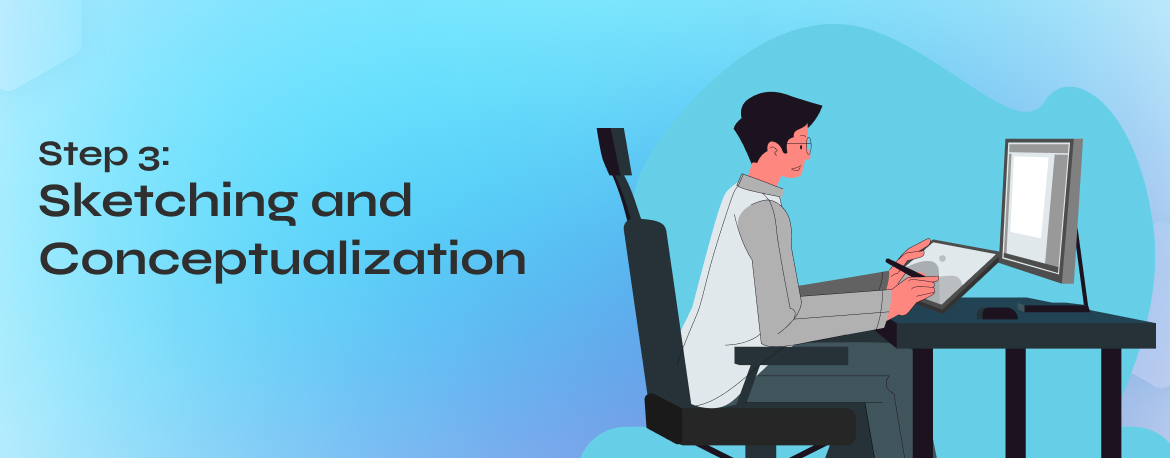
With a clear direction established, the process moves into a more tangible phase of Sketching and Conceptualization. This stage bridges the gap between abstract ideas and concrete designs, allowing for exploration and iteration.
Brainstorming
Effective brainstorming sessions enable designers to explore a breadth of ideas quickly. Techniques such as mind mapping, word association, and sketching facilitate the generation of concepts that can be developed further. This part of the process is crucial for unleashing creativity and ensuring a wide range of potential solutions are considered.
Sketching
Sketching by hand is an invaluable tool for quickly iterating design ideas. It allows designers to explore compositions, layouts, and visual elements without the constraints of software. These sketches form the basis of the design, providing a flexible framework that can be refined and developed.
Digital Drafts
Transitioning from hand-drawn sketches to digital drafts marks a significant step in the design process. Using software like Adobe Creative Suite, designers begin to bring their concepts to life with precision and flexibility. This stage involves selecting typography, colors, and imagery, as well as applying layout principles to create a cohesive design. The term “how to create a graphic design” underscores the technical and creative skills required to transform initial concepts into polished designs.
Step 4: Design and Development
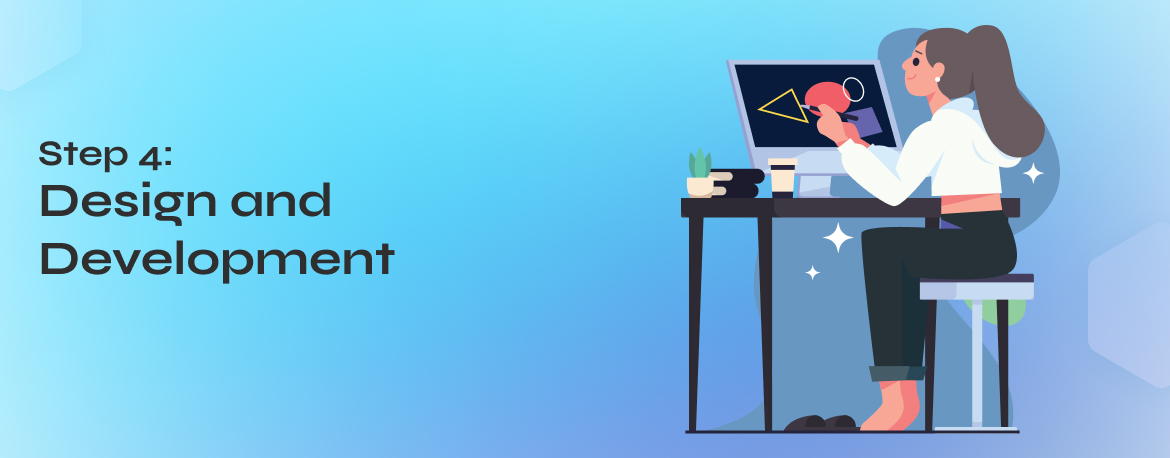
The fourth phase, Design and Development, is where the creative vision becomes a reality. This step involves the detailed execution of the design concept, using specialized software and tools to refine and perfect the design.
Software and Tools
Graphic designers rely on a suite of software to create their work, with Adobe Creative Suite being among the most popular. These tools offer vast capabilities for image editing, vector graphics, layout, and typography, enabling designers to execute their ideas with precision.
Design Execution
This stage is about applying the principles of design—such as balance, contrast, hierarchy, and alignment—to create a visually compelling and effective design. It involves meticulous attention to detail, from the choice of color palette and fonts to the spacing and alignment of elements. The process is iterative, with designs being refined and adjusted based on aesthetic judgment and project requirements.
Feedback and Revisions
Feedback is a crucial part of the design and development phase. Presenting the design to the client or stakeholders and receiving their input ensures that the design aligns with their expectations and objectives. Based on this feedback, revisions are made, which may involve tweaking the design, experimenting with different elements, or sometimes, significant changes to align with the client’s vision.
Step 5: Delivery and Evaluation

The final step in the graphic design process is Delivery and Evaluation. This phase involves preparing the design for final delivery, presenting it to the client, and reflecting on the project to glean insights for future work.
Finalizing Designs
Preparing the final design files for delivery requires attention to detail and an understanding of the formats needed for various applications, whether for print or digital use. This includes ensuring the resolution, color profiles, and file types are appropriate for the medium in which the design will be used.
Client Presentation
Presenting the final design to the client is an opportunity to showcase the work and explain the design decisions made throughout the process. It’s a chance to demonstrate how the design meets the project’s objectives and to highlight the creative and strategic thinking that went into the project.
Evaluation and Feedback
After the design is delivered, soliciting feedback from the client and reflecting on the project’s success and areas for improvement is vital. This evaluation phase helps designers learn and grow, refining their process and approach for future projects. It’s an opportunity to assess what worked well and what could be done differently, ensuring continuous improvement in the graphic design process.
FAQs
What is the Graphic Design Process?
The graphic design process is a series of steps a designer follows to create visual content. It involves understanding client needs, conducting research, brainstorming and conceptualizing ideas, creating designs, and finally, delivering the finished product. This structured approach ensures efficiency and creativity in meeting the project’s objectives.
Why is the Graphic Design Process Important?
Following a graphic design process is crucial because it provides a clear framework that helps designers manage projects, foster creativity, and ensure client satisfaction. It streamlines the workflow, making it easier to deliver high-quality designs that meet or exceed expectations.
What Are the Five Phases of the Graphic Design Process?
The five phases are:
- Brief and Consultation
- Research and Inspiration
- Sketching and Conceptualization
- Design and Development
- Delivery and Evaluation
These steps guide the project from initial concept to final delivery, ensuring a comprehensive approach to design.
How Does Research Fit Into the Graphic Design Process?
Research is crucial in the graphic design process because it informs the designer about the target audience, market trends, and competitor strategies. This knowledge ensures that the design not only looks good but also resonates with the intended audience and stands out in the market.
Can You Skip Steps in the Graphic Design Process?
While it might be tempting to skip steps to save time, doing so can compromise the quality and effectiveness of the design. Each phase of the process plays a crucial role in ensuring the final design meets the project’s goals and client expectations.
How Do Graphic Designers Find Inspiration?
Graphic designers find inspiration through various sources, such as design blogs, art, nature, history, and even everyday objects. Inspiration gathering is a dynamic phase where designers open their minds to diverse visual stimuli to spark creativity.
What Tools Do Graphic Designers Use in the Design and Development Phase?
Graphic designers commonly use digital tools and software, like Adobe Photoshop, Illustrator, and InDesign. These tools provide the flexibility to experiment with different elements, such as typography, colors, and layouts, to create polished designs.
How Important is Client Feedback in the Graphic Design Process?
Client feedback is vital as it ensures the design aligns with the client’s vision and objectives. It’s a collaborative process where feedback is used to refine and improve the design, leading to a more successful outcome.
What Happens in the Delivery and Evaluation Phase?
In the delivery and evaluation phase, the final design is prepared for handoff to the client, including any necessary formats or files. Then, the project is reviewed to assess its success and gather insights for future projects. This phase is crucial for learning and growth.
How Can I Start My Own Graphic Design Process?
To start your own graphic design process, begin by understanding the project’s goals and your client’s needs. From there, follow the structured steps: conduct research, brainstorm, sketch, design, and finally, deliver and evaluate your work. Remember, flexibility and adaptability are key, as each project might require a slightly different approach.
Conclusion
The Ultimate 5-Step Graphic Design Process offers a structured approach to creating impactful and effective designs. From the initial briefing and consultation to the final delivery and evaluation, each step plays an important role in ensuring the project’s success. By following these steps, designers can navigate the complexities of creative work, meet client expectations, and produce designs that stand out in a crowded visual landscape. This process streamlines workflow and fosters creativity, collaboration, and continuous improvement, making it an essential framework for any graphic design project.

